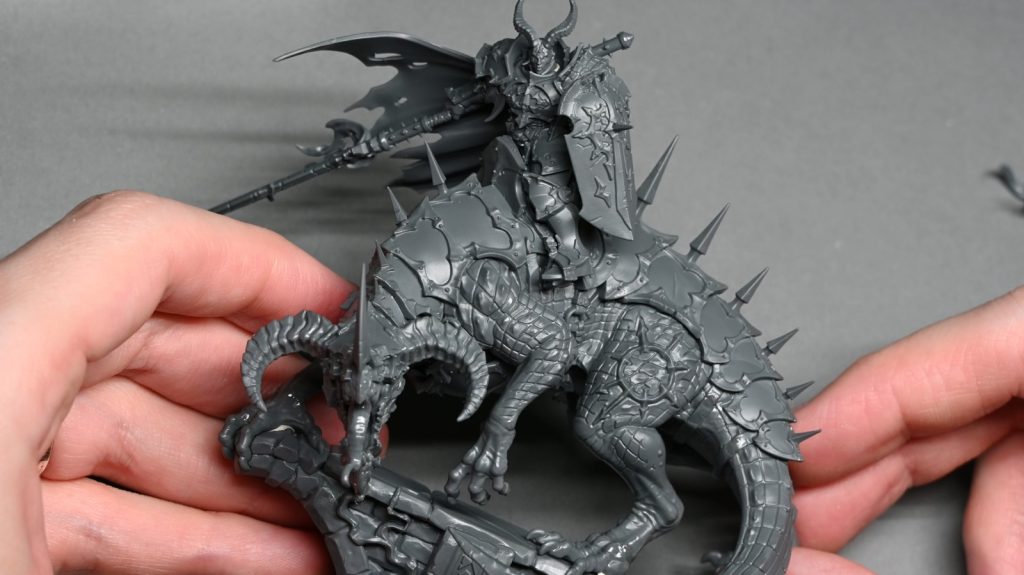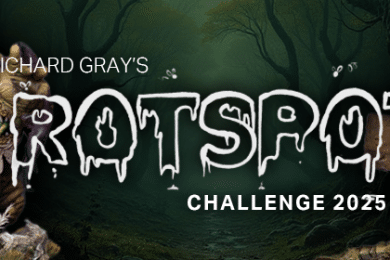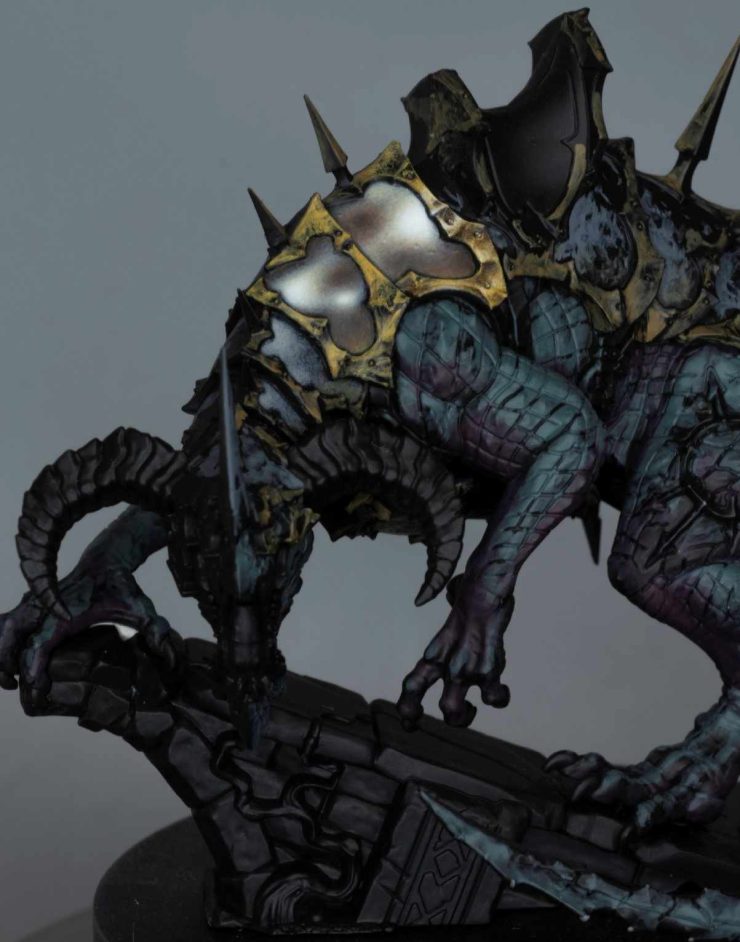All of the video tutorials for how to paint Abraxia from the Slaves to Darkness army. We have how to paint her head, with tips on skin and horns, her cloak and the NMM (non-metallic-metal) armour on her fearsome mount! Scroll to the bottom for links to how to assemble the model, too.
Video: How to Paint Abraxias Head
Paints Used
- Games Workshop:
- Rhinox Hide
- Mournfang Brown
- Balor Brown (Alternative to Tuskgor Fur)
- Evil Sunz Scarlet
- XV-88
- Morghast Bone
- Ushabti Bone
- Screaming Skull
- Vallejo:
- Model Colour Black
- Model Colour Ice Yellow
- P3:
- Morrow White
Brushes
- Artis Opus:
- Series M or S, Size 00 (for details and glazing)
Other Materials
- Sprue glue
- Tamiya Extra Thin Cement
- Wet palette
- Lamp (for highlighting)
- Blue Tac (for holding the miniature)
How to Paint Abraxias Head
Step 1: Prep Work and Eye Basecoat
- Forehead Conversion: If desired, remove the protruding spike and fill it in for a smoother look. Use sprue glue and a touch of Tamiya Extra Thin to blend it seamlessly.
- Eye Basecoat: For the whites of the eyes, use a light yellow colour like Citadel’s Ice Yellow. Avoid pure white, as it won’t make the white dot “pop” later.
- Eye Challenges: Note the sculpted dots on the eyes, intended for glowing demon eyes. We’ll work around these to create a more human look. Scars running through the lower eyes will be addressed throughout the painting process.
Step 2: Skin Basecoat and Highlight Placement
- Skin Basecoat: Apply a generous coat of Mournfang Brown. Use a 1:1 ratio of paint to water for a smooth application.
- Over-Highlighting: Don’t just highlight the shiny spots under a lamp. Cover the majority of the head with Mournfang Brown to avoid high contrasts later.
- Light Direction: Consider the direction of the light source for your highlights. I’m working with a top-left angle, focusing highlights there but ensuring ample coverage on the right side as well.
Step 3: Skin Highlights
- Highlight Colours: Use a mix of Mournfang Brown with a tiny bit of Tuskgor Fur (or Ushabti Bone if you find Tuskgor Fur too grainy), gradually increasing the amount of Tuskgor Fur for lighter highlights.
- Blending: Carefully blend the highlight colours together, using a size z00 Artis Opus brush with a tiny amount of paint.
- Glazing: After highlighting, use watered-down Mournfang Brown (3-4 parts water to 1 part paint) and Rhinox Hide for glazing. This will smooth the transitions and enhance the shadows.
Step 4: Horns
- Horn Basecoat: Apply Mournfang Brown to the horns.
- Horn Highlight Colours: Use XV-88, Morghast Bone, Screaming Skull, and white to highlight the horns.
- Horn Gradient: Aim for a light-to-dark gradient, with the base of the horns being the lightest and the tips the darkest. You can achieve this through wet blending, applying the colours while the paint is still wet.
- Horn Texture: Use the tip of your brush to create a stippling or scratching effect for a textured look. Vary the strokes and avoid uniform patterns.
Step 5: Eyes and Lips
- Eye Refinement: Gradually fill in the scars on the lower eyes with the same light yellow used for the basecoat. Be patient and build up the layers for a smooth finish.
- Pupil: Paint a small white dot in the centre of each eye. Aim for similar size and shape for both eyes.
- Lip Colour: Leave the upper lip black, but paint the lower lip with a mix of Evil Sunz Scarlet and white. Use the lightest mix for the brightest highlights.
- Lip Details: Carefully define the shape of the lips with black paint, adding a slight highlight to the ridge below the nose. Add tiny lines on the sides of the mouth for added expression.
Step 6: Final Touches
- Makeup: Extend the black around the eyes to create a “tick” that goes up towards the temple on both sides.
- Refinement: Keep refining the highlights, shadows, and textures until you’re happy with the result.
Video: How to Paint the Cloak for Abraxia
Paints Used
Games Workshop Paints: Khorne Red, Evil Sunz Scarlet, Barak-Nar Burgundy
Vallejo Paints: Old Rose, Ice Yellow
Brushes
- Artis Opus: Various sizes including a size 1 and larger for blending, but any high-quality brush of a similar size is great.
Other Materials
- Tamiya sanding pads (for smoothing out any imperfections or rough patches in the paint)
- Wet palette
- Airbrush (optional)
- Scalpel (for cleanup of the miniature before painting)
How to Paint the Cloak Steps
Step 1: Airbrushing the Base Coat (Optional):
- Prime: Start with a white primer.
- Base Coat: Apply a few thin coats of Khorne Red using your airbrush.
- Highlight: Lightly dust the raised areas with white from a top-down angle.
- Midtone: Airbrush Evil Sunz Scarlet, adding subtle tonal variation.
- Shadow: Tilt the model back and airbrush Barak-Nar Burgundy on downward-facing areas.
Note: This airbrushing step is optional. If you prefer, you can achieve a similar base by painting Khorne Red directly onto a black undercoat.
Step 2: Hand-Painting Highlights and Shadows:
Wet Palette: Prepare a wet palette with the following colours:
- Evil Sunz Scarlet
- Evil Sunz Scarlet mixed with Old Rose
- Old Rose
- Old Rose mixed with Ice Yellow
- Ice Yellow
- Evil Sunz Scarlet mixed with Barak-Nar Burgundy (various ratios)
- Barak-Nar Burgundy
- Highlighting: Use a size 1 brush (or larger) to apply highlights with Evil Sunz Scarlet mixed with a small amount of Old Rose. Follow the natural curves and contours of the cloak, focusing on areas where light would naturally fall.
- Blocking in Shadows: Use Khorne Red (or a mix of Khorne Red and Barak-Nar Burgundy) to block in shadow areas. Don’t worry about perfect blending at this stage; focus on establishing tonal contrast.
- Refining Transitions: Switch to a larger brush (size 2 or 3) for smoother blending. Use a pulling motion, dragging the paint from the highlights into the shadows.
- Glazing: Thin your paints with water (4-5 parts water to 1 part paint) and apply glazes to smooth out transitions and unify the colours.
Step 3: Adding Weathering and Texture:
- Thinned Paints: Use a 1:1 ratio of paint to water for texture.
- Fraying: With a fine brush, apply short, feathery strokes of a slightly lighter, desaturated red (e.g., Barak-Nar Burgundy mixed with Khorne Red and Old Rose) to the edges of the cloak to simulate fraying.
- Scratches: Create fine scratches using the same desaturated red. Vary the direction and length of the scratches for a natural look.
- Refinement: Glazing can be used to soften harsh lines and create subtle variations in colour and texture.
Additional Tips:
- Use a lamp to identify natural highlights and shadows on the cloak.
- Don’t be afraid to experiment and personalise your weathering effects! Make her cloak unique to you and have fun.
Video: How to Paint the Abraxia Mount NMM Armour Panel
Materials
- Games Workshop paints: Rhinox Hide, Mournfang Brown, XV-88, Abaddon Black, Sons of Horus Green, Barak-Nar Burgundy
- Vallejo paints: Ice Yellow, Neutral Grey, Heavy Grey
- Two Thin Coats paint: Dark Sun Yellow
- P3 paint: Morrow White
- Various Artist Opus brushes, including size 1 and size 2
Steps to Follow
Step 1: Block in the Colours
- Begin by roughly blocking in the colours on the entire model using a size 1 brush. This helps to establish the overall colour scheme and provides a base for the highlights.
- Use Neutral Grey for the armour plates and XV-88 for the gold trim.
- Apply Sons of Horus Green and Barak-Nar Burgundy to the skin areas.
Step 2: Refine the Armour Plates
- Choose an armour panel to focus on and begin refining the NMM effect.
- Start with Neutral Grey and gradually add Ice Yellow to create a series of increasingly lighter highlights.
- Use a variety of brush strokes to create texture and variation in the reflections, ensuring a “micro texture” that is smooth and detailed.
- Consider the overall lighting of the model and place the highlights accordingly.
- Glaze with Mournfang Brown and Rhinox Hide to add depth and warmth to the shadows.
- Use P3 Morrow White for the final highlights, creating smooth transitions and a bright, opaque finish.
Step 3: Add Weathering and Details
- Use a smaller brush to add scratches, dents, and other details to the armour plates, turning the marks from the initial blocking in into realistic battle damage.
- Vary the colours of the weathering based on the surrounding area, using darker greys or black in shadowed areas and lighter greys or white in highlighted areas.
- Glaze with white to create a smooth, opaque finish on the brightest highlights, enhancing the illusion of reflected light.
Step 4: Repeat for Additional Panels
- Repeat the process for the remaining armour panels, adjusting the placement and intensity of the highlights to match the overall lighting scheme.
- Remember that the highlights should become smaller and darker as you move away from the main focal point of the model.
How to Build Abraxia! PDF and Video Guide!

How to Build Abraxia, With Tips!
This video and step by step guide shows the whole process how to build Abraxia, building and cleaning in preparation for painting. I go over lots of little tips and tricks, too!
If you don’t have an account here on my website, please sign up here! I have over 350 video tutorials with steps and tips, plus a selection of PDFs. If you are not sure about joining, you can explore my free videos with a free membership, or take the plunge and become a full subscriber for full access.
If you’d prefer to support me on Patreon, please visit: https://www.patreon.com/RichardGray







